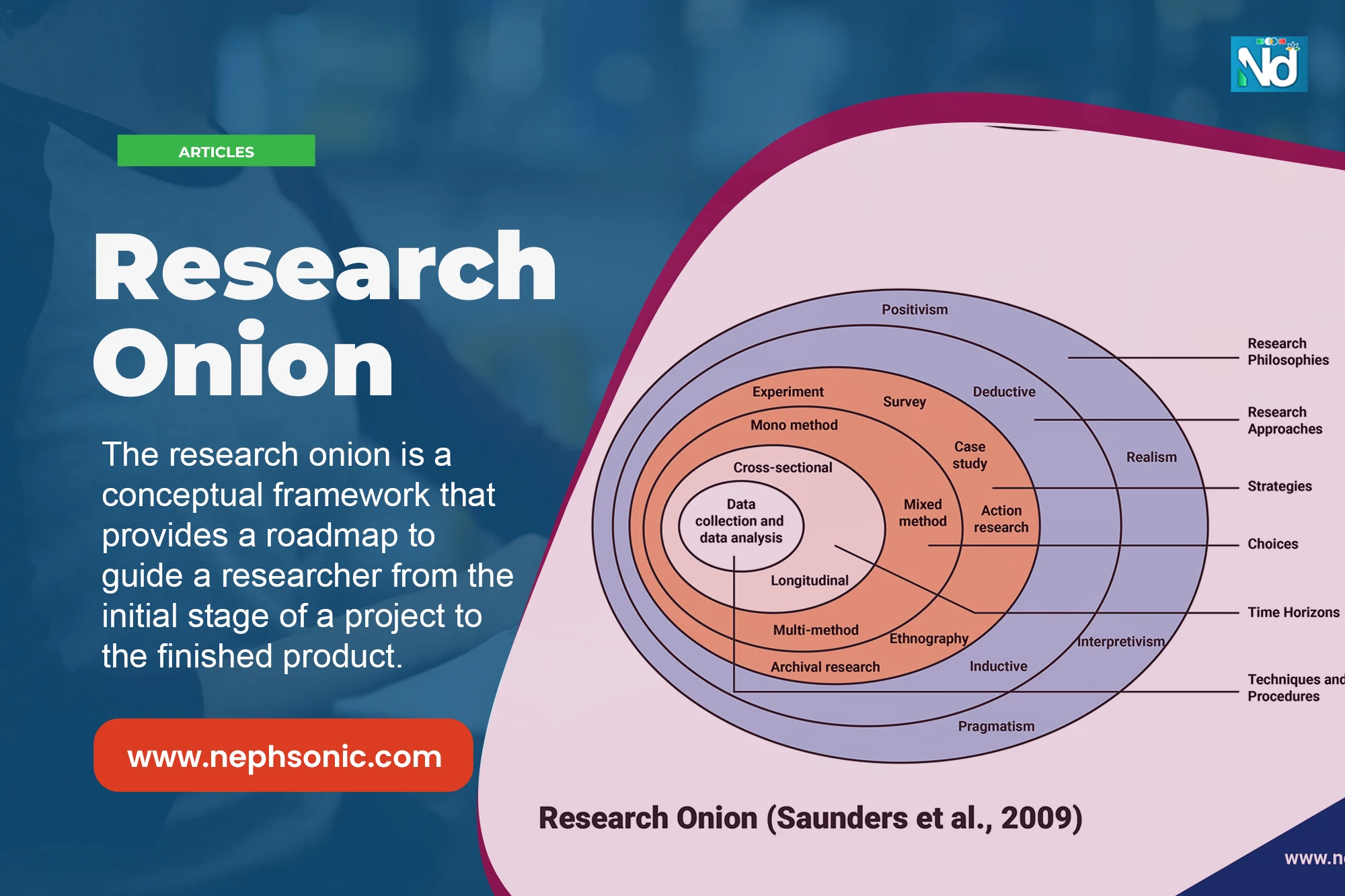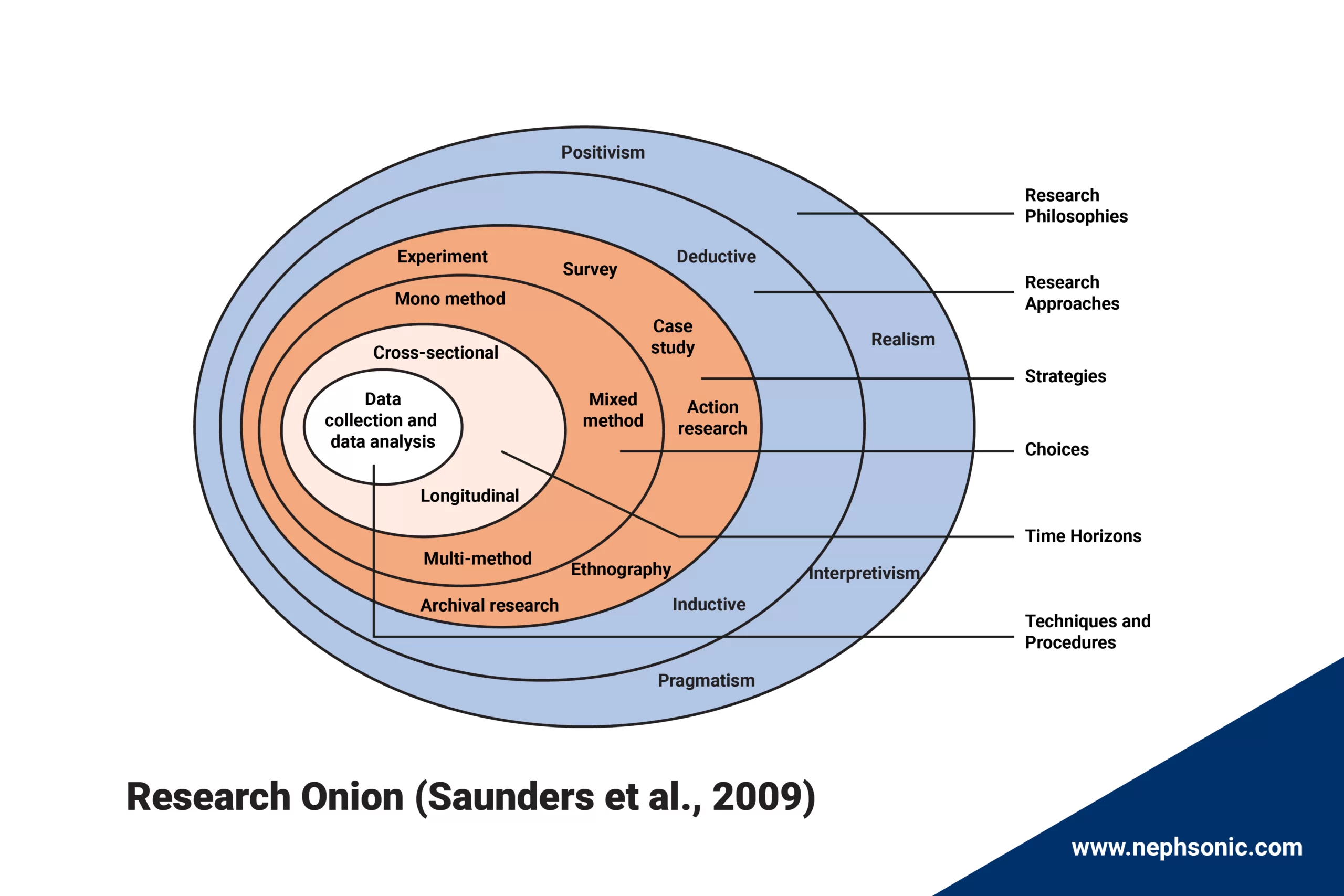This article offers a comprehensive guide to understanding and crafting an effective research methodology chapter for your thesis or dissertation, with a focus on the Research Onion framework by Saunders, Lewis, and Thornhill (2016).
Understanding the Research Onion (Saunders et al., 2015)

Understanding the Research Onion (Saunders et al., 2015)
-
By: Nephtali Tshitadi
- Published:
1. Introduction
Research is an essential process for understanding complex issues, shaping policies, validating theories, and generating insights into the world. At its core, research is a systematic and structured approach to gathering data, analyzing information, and drawing conclusions that address specific questions or problems (Sujatha, 2016). However, navigating the research process can be daunting, especially for postgraduate students, who often face challenges in deciding on research questions, choosing suitable methodologies, and understanding the most appropriate design and data collection methods.
The high dropout rates among postgraduate students worldwide underscore the difficulties of research. A study by Styger Vuuren and Heymans (2014) revealed that, in South African universities, the dropout rates for Master’s degrees ranged from 30% to 67%, while for doctoral degrees, the rates were between 50% and 68%. Similarly, Bekova and Dzhafarova (2019) reported that the dropout rate for certain Ph.D. programs in Spain ranges from 70% to 90%, while in Australia it was approximately 30%, and around 50% in the USA. Even the most developed European countries face a 40% to 50% dropout rate of engineering students during their first year, and the rate can be as high as 80% for some engineering disciplines (Sultana et al., 2017; Kabashi et al., 2022). These statistics reflect the challenges posed by academic research, which demands significant commitment, resilience, and support.
Multiple factors contribute to these dropout rates, including individual challenges like mental health issues and anxiety (Peng et al., 2022; Nadeem & Palaniappan, 2021) and institutional factors such as inadequate supervision and research preparation (Cobbing et al., 2017; Styger et al., 2014). Additionally, socioeconomic barriers (such as the cost of education and gender disparity), limited academic counseling, and lack of experience in academic writing add further obstacles for many students (Alabi et al., 2019; Schmidt & Umans, 2014; Litalien & Guay, 20Haider, 2021; Nadeem, Palaniappan & Haider, 2021). These factors collectively show that postgraduate research is a complex and challenging endeavor requiring careful attention to various factors in order to mitigate dropout rates and promote successful completion
Despite these challenges, resources and frameworks are available to guide researchers through this complex process. One such resource is the Research Onion Model by Saunders et al. (2016). This framework offers a structured roadmap for developing a robust research methodology, providing step-by-step guidance from initial planning to completion. By breaking down the methodology into layered stages, the Research Onion helps researchers address the core aspects of their project systematically.
In this article, we will explore the Research Onion model in detail, illustrating how it can serve as a valuable tool for constructing an effective research methodology chapter. We will also address common misconceptions in research methods, showing how the Onion framework can help avoid these pitfalls and lead to a more successful research journey.
2. What is the Research Onion?
2.1. Definition of the Research Onion Model
The Research Onion model, developed by Saunders, Lewis, and Thornhill (2009), provides a structured framework to guide researchers through the essential layers of research design, from selecting philosophical foundations to choosing specific techniques. Each layer represents a crucial decision that researchers need to address as they design their studies, with outer layers setting the foundational direction and inner layers focusing on methodological specifics (Ko & Abdulmajeed, 2022).
2.2. Purpose of the Model
The primary purpose of the Research Onion model is to simplify the process of designing a research project by breaking it down into sequential stages. This layered approach encourages researchers to consider their philosophical stance, the appropriate methodological approach, strategies, time horizons, and data collection techniques. Each decision within a layer is influenced by previous choices, ensuring that each stage is coherent and logically aligned with the overarching research question (Alturki, 2021).
2.3. Why it’s called an “Onion”
The model is termed an “onion” because it consists of multiple layers, just like an onion, that must be “peeled” away progressively until the core of the research methodology is reached. This means moving from broader considerations to specific methodological details. This structure helps researchers ensure that each methodological choice is consistent with the overall research objective. The onion metaphor highlights how researchers, like peeling layers of an onion, tackle each aspect in a logical, stepwise fashion to address all relevant aspects of their study (Asher & Popper, 2019). Starting from broad philosophical considerations in the outer layers, researchers work inward to refine the specifics of their methodology.

This approach ensures that researchers make well-informed, cohesive decisions throughout the research process, aligning each element of their methodology to achieve robust, credible outcomes.
3. The Layers of the Research Onion
Saunders et al. (2016)’s Research Onion provides a structured framework for developing a research methodology by breaking down the research design into six logical layers. This layered approach, starting with broad philosophical foundations and moving towards specific techniques, ensures that each methodological decision builds on prior choices. This method helps researchers make informed, coherent decisions that align with their research goals and questions.

The layers of the Research Onion include:
- Philosophies: Sets the foundational stance of the research, guiding how researchers view knowledge and reality, which in turn shapes their study.
- Approaches: Encompasses deductive and inductive reasoning, determining whether the research aims to test existing theories or generate new ones.
- Strategies: Provides various methodological pathways such as experiments, surveys, or case studies, each suited to specific types of research.
- Choices: Refers to the decision between single method, mixed-method, or multi-method approaches, offering flexibility in handling data collection and analysis.
- Time Horizons: Specifies whether the research will be cross-sectional (snapshot in time) or longitudinal (observing changes over time).
- Techniques and Procedures: The core layer, which involves specific data collection and analysis methods tailored to the research context.
3.1. Research Philosophies
The first layer of the research onion is the research philosophy. This is the outermost layer and represents the researcher’s underlying philosophical beliefs and assumptions. Research philosophy is about how you view the world. It includes your beliefs about the nature of the truth you are investigating: WHAT is important, and WHY is it important?
As such, the researcher should be able to answer the following questions: what personal values do you bring to the topic? How will they influence your choice of methodologies and procedures? What impact might they have on the validity of your results? Bajpai (2011) suggested the research philosophy helps you decide what types of data to collect, how to collect it, and how to analyze it.
Academic studies frequently adopt four distinct philosophical orientations in research: positivism, interpretivism, pragmatism, and realism (Saunders et al., 2007; Žukauskas, Vveinhardt, & Andriukaitienė, 2018).
1.1. Positivism
Positivism is based on the assumption that the world is objective and that scientific methods are the best way to understand it. The advocates of positivism support the idea of objectivism. In other words, reality can be known objectively through systematic observation and measurement. From this viewpoint, researchers are considered objective observers who examine phenomena that are independent of them (Rehman and Alharthi, 2016). They use symbols and words to describe things as they exist without any interference (Rehman & Alharthi, 2016).
The positivist approach is fundamentally rooted in scientific methods, diligently attempting to explain the underlying causes and effects of various phenomena. It is particularly well-suited for quantitative studies, where researchers employ techniques such as surveys, experiments, and simulations to rigorously gather and analyze data (Holden & Lynch, 2004).
1.2. Interpretivism
Interpretivism focuses on understanding human behaviour by closely examining people’s experiences, interpretations, and perspectives (Bajpai, 2011). The advocates of positivism support the idea of subjectivism. They believe reality is subjective and there are no universal truths (Saunders et al., 2009). This means truth must be created and interpreted subjectively. Individuals must make sense of their own experiences to understand and interpret the world around them. Interpretivism often uses qualitative methods such as interviews, focus groups and observations to collect data (Bajpai, 2011).
1.3. Pragmatism
Pragmatism is a philosophical approach that emphasizes practicality or usefulness as the ultimate criterion for judging truth (Saunders et al., 2009). In other words, pragmatism is committed to using evidence and reason to determine what works best in the real world. It focuses on practical outcomes rather than abstract theories. Pragmatist researchers believe in the efficacy of using practical experience and empirical evidence to determine the truth or falsity of propositions.
The meaning of concepts or ideas cannot be ascertained apart from their use in the context of actual situations. Pragmatism is often contrasted with the epistemological perspective, which holds that knowledge can be derived from a source independent of experience. The following research methods are commonly associated with Pragmatism: empirical observation, experimentation, and survey research.
1.4. Realism
Realism is a philosophical position that believes that the world is fundamentally the same as it is in reality and that the only thing that really matters is what is real. Researchers who adhere to this view believe that there are facts out there that exist independently of human thought or perception. While our perceptions may influence what we observe, ultimately the real world exists outside of our experience or belief. As a result, science can provide us with knowledge about these objective realities (Bajpai, 2011).
Despite the inherent disparities among these philosophical approaches, it’s important to note that one isn’t inherently superior to the others. Instead, researchers may tend to gravitate towards a particular philosophy based on their preferences and the nature of their research (Podsakoff et al., 2012).
2.2. Research Approaches
The second layer of the research onion is the research approach. The onion suggests that a research approach must be selected once the appropriate methodology is chosen.
According to Saunders et al (2015), there are two main approaches to research: inductive and deductive.
2.1. Inductive research
Inductive research is a type of inquiry that starts with specific observations or experiences and then generalizes them to form theories or hypotheses. The inductive approach is based on interpretivism (Temitope and Udayangani, 2015). This means that the researcher uses his or her personal experiences, observations, and knowledge to form theories that explain the phenomenon being studied. For this reason, inductive research is often considered a more qualitative approach than deductive research.
For example: suppose you are interested in how people use social media to learn about products. In that case, you might start by collecting data through surveys or interviews, asking people about their experiences buying products online or offline and then draw conclusions based on those interviews. We can see here that the researcher goes from specific to general levels of focus.
As outlined by Bryman and Bell (2011), the inductive approach is predominantly employed in qualitative research. This is particularly advantageous because it obviates the necessity for a guiding theory, which, in turn, diminishes the likelihood of researcher bias during the data gathering phase.
Figure 2 below provides a visual representation of the procedural steps entailed in conducting research utilizing an inductive approach:

2.2. Deductive research
Deductive research starts with a hypothesis or theory that has been established by previous research and then seeks evidence to support or reject it. Here, the researcher goes from general principles to make predictions about what will happen in a specific situation. This approach is based on positivism, i.e. the researcher uses objective methods to gather data from many sources in order to make generalizations about human behavior.
2.3. Research Strategies
2.4. Methodological Choices
2.5. Time Horizons
2.6. Data Collection & Analysis techniques
Common Mistakes to Avoid
Conclusion
References

Nephtali Tshitadi
Nephtali Tshitadi is a researcher and professional content writer with more than 5 years of experience. He holds a Masters's qualification (Mcom) in Finance, Honours Degree in Financial Management, and BCom in Economics.
Website: https://nephsonic.com
Follow Us
Recent Posts
Understanding the Research Onion (Saunders et al., 2015)
January 18, 2024
When it’s all been said and done, what truly matters? (Part 4)
December 28, 2023

